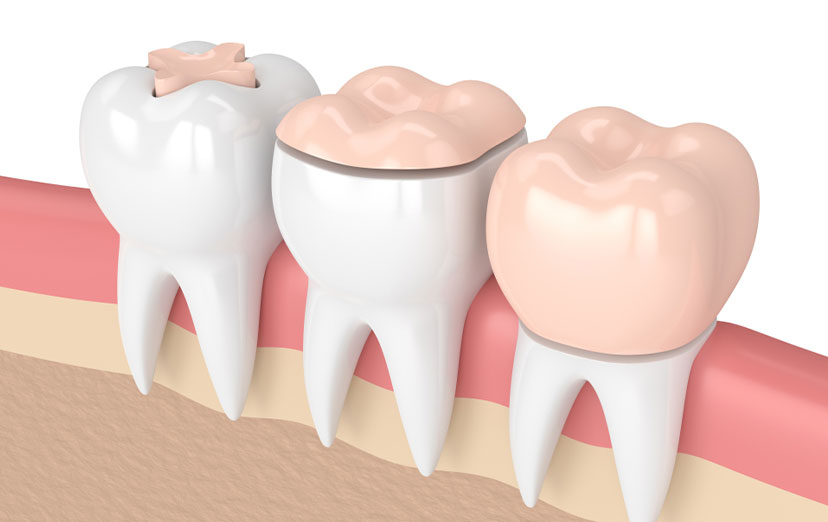
Understanding the Basics of Inlays & Onlays
Dental inlays and onlays are restorative dental procedures that help preserve the natural tooth structure. Inlays are used when the decay or damage is within the cusp of the tooth, while onlays are used when the damage extends to one or more cusps.
Made from durable materials like porcelain or composite resin, these restorations provide strength and longevity. They are a great alternative to traditional metal fillings and can be color-matched to blend with your natural teeth.
Inlays and onlays are often recommended for small cavities or when there is not enough damage to warrant a crown. By choosing inlays and onlays, you can ensure a strong and aesthetically pleasing solution for your dental needs.
What are Dental Inlays?
Dental inlays are a customized solution used to repair cavities of various sizes. Made from materials like porcelain or composite resin, they seamlessly fit into the affected area of the tooth. Inlays provide a natural appearance, resist staining, and offer long-lasting restoration for teeth.
What are Dental Onlays?
Dental onlays are a restorative dentistry option used to repair extensive cavities or damage that extends to the cusps of the tooth. Made from materials like porcelain or composite resin, onlays cover a larger surface area than inlays and provide a strong and durable restoration. They help restore the chewing surface of the tooth.
Comparing Inlays and Onlays with Other Restorative Dentistry Options
When it comes to restorative dentistry options, inlays and onlays offer unique benefits compared to other alternatives. Inlays provide a conservative alternative to dental fillings, preserving the natural tooth structure while effectively treating tooth decay. On the other hand, onlays offer a more extensive restoration compared to dental crowns, covering a larger surface area and providing support for damaged cusps.
Inlays vs. Fillings
Inlays and fillings are two common methods used in restorative dentistry. Inlays are typically used for larger cavities or when more extensive restoration is needed, while fillings are usually used for smaller cavities.
The main difference between the two lies in their durability and longevity. Inlays provide a stronger and longer-lasting solution compared to fillings. They are custom-made to fit precisely into the affected area of the tooth, providing a natural appearance and resistance to staining.
Fillings, on the other hand, are made from materials like composite resin or amalgam. They are generally used for smaller cavities and are not as durable as inlays. By choosing the right option, such as inlays, you can ensure a more long-term and effective solution for your dental needs.
Onlays vs. Crowns
Onlays are chosen when the damage extends to one or more cusps of the tooth, while dental crowns are typically used when the entire tooth structure is compromised.
One key difference between these two options is that onlays provide a more conservative restoration compared to crowns. This means that onlays require less tooth preparation, preserving more of the natural tooth structure.
Additionally, onlays are known for their durability and ability to preserve the strength of the tooth. So, if you’re looking for a long-lasting and conservative solution for your damaged tooth, onlays may be a great choice.
Why Choose Inlays and Onlays over Traditional Methods?
Inlays and onlays are custom-made restorations that offer numerous benefits for dental restoration. They provide strength, durability, and a seamless appearance by precisely fitting into the damaged area. In addition to being stain-resistant, they also help prevent tooth decay.
These restorations are an excellent alternative to metal fillings as they provide conservative and long-lasting results. Inlays and onlays are an ideal choice for those seeking aesthetic and functional benefits in a reliable tooth restoration solution.
Steps Involved in the Application of Inlays and Onlays
To apply inlays and onlays, your dentist will first prepare the affected tooth by removing any tooth decay or damage. This ensures a clean surface for the restoration process.
Next, an impression of the tooth is taken to create a custom-made inlay or onlay that fits perfectly. The fabrication of the inlay or onlay takes place in a dental laboratory, where materials like ceramic or metal alloys are used.
Once ready, the dentist bonds the inlay or onlay to the tooth using a dental adhesive, ensuring a secure attachment. Any necessary adjustments are made to guarantee a proper fit and bite.
By following these steps, we can effectively restore teeth with inlays and onlays to their natural appearance and functionality.
Call Sensational Smiles for more information, today!
Inlays and onlays provide an excellent alternative to traditional restorative dentistry options. With their precise fit, durability, and aesthetic appeal, they offer numerous benefits for those seeking to restore and preserve the health of their teeth. If you’re looking to enhance the appearance and functionality of your teeth while maintaining their natural structure, consider discussing the possibility of inlays and onlays with the experts at Sensational Smiles. Together, we can determine the best course of action for achieving a healthy, beautiful smile that lasts.











